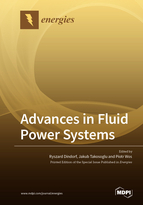Advances in Fluid Power Systems
A special issue of Energies (ISSN 1996-1073).
Deadline for manuscript submissions: closed (20 August 2021) | Viewed by 31786
Special Issue Editors
Interests: fluid power drives and controls; mechatronics engineering; production process automation
Special Issues, Collections and Topics in MDPI journals
Interests: fluid power drives and controls; mechatronics engineering; fuzzy-logic control; pneumatic manipulators
Special Issues, Collections and Topics in MDPI journals
Interests: fluid power drives and controls; mechatronics engineering; adaptive control; hydraulic manipulators
Special Issues, Collections and Topics in MDPI journals
Special Issue Information
Dear Colleagues,
The Guest Editors are inviting submissions for a Special Issue of Energies on the subject area of "Advances in Fluid Power Systems”. Fluid power systems (hydraulic and pneumatic drives and control) involve the use of fluid properties to generate, control, and transmit power using pressurized fluid flow. Fluid power systems are simple and easy to use, which can accurately control position, speed, force, and torque, and are economical and safe to operate. The fluid power system sector is undergoing tremendous expansion, invigorating strategic companies—power engineering, oil and gas industry, mining industry, shipbuilding, steel industry, machine industry, and metal processing. There are major challenges for fluid power systems, such as increasing energy efficiency, improving reliability, building smart components and systems, reducing the size and weight of components, reducing environmental impact, improving the capabilities for recovery and storage of energy for reuse, digitalization, and 5G wireless connectivity of smart components. Advances in fluid power systems are leading to the creation of new smart devices replacing tried-and-true solutions of the past. This Special Issue focuses on the recent advances and smart of fluid power systems in a wide range of topics, including the following:
- Fluid power to the IoT and Industry0
- Smart fluid power technology
- Wireless 5G connectivity in fluid power
- Smart components and sensors
- Fluid power in the renewable energy sector
- Hydraulic drivetrains for wind power
- Hydraulic drivetrains for wave and marine current power
- Hydraulic systems for solar power
- Fluid power hybrid
- Hybrid transmissions
- Energy recovery and accumulation
- Energy efficiency of hybrid drives
- Industrial and mobile fluid power
- Industrial fluid power solutions
- Mobile fluid power solutions
- Energy efficiency solutions for fluid power systems
- Environmental aspects of fluid power
- Water hydraulic control technology
- Noise and vibration of fluid power components
- Safety, reliability, fault analysis and diagnosis of fluid power systems
- Fluid Power and Mechatronic Systems
- Servo-drive control systems
- Fluid power drives in manipulators and robots
- Fluid power in autonomous solutions
Prof. Ryszard Dindorf
Assoc. Prof. Jakub Takosoglu
Asst. Prof. Piotr Wos
Guest Editors
Manuscript Submission Information
Manuscripts should be submitted online at www.mdpi.com by registering and logging in to this website. Once you are registered, click here to go to the submission form. Manuscripts can be submitted until the deadline. All submissions that pass pre-check are peer-reviewed. Accepted papers will be published continuously in the journal (as soon as accepted) and will be listed together on the special issue website. Research articles, review articles as well as short communications are invited. For planned papers, a title and short abstract (about 100 words) can be sent to the Editorial Office for announcement on this website.
Submitted manuscripts should not have been published previously, nor be under consideration for publication elsewhere (except conference proceedings papers). All manuscripts are thoroughly refereed through a single-blind peer-review process. A guide for authors and other relevant information for submission of manuscripts is available on the Instructions for Authors page. Energies is an international peer-reviewed open access semimonthly journal published by MDPI.
Please visit the Instructions for Authors page before submitting a manuscript. The Article Processing Charge (APC) for publication in this open access journal is 2600 CHF (Swiss Francs). Submitted papers should be well formatted and use good English. Authors may use MDPI's English editing service prior to publication or during author revisions.
Keywords
- Fluid power
- Hydraulics
- Pneumatics
- Control systems
- Drives systems
- Mechatronics
- Autonomous solutions
- Industry 4.0
- Hybrid systems







